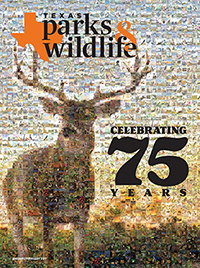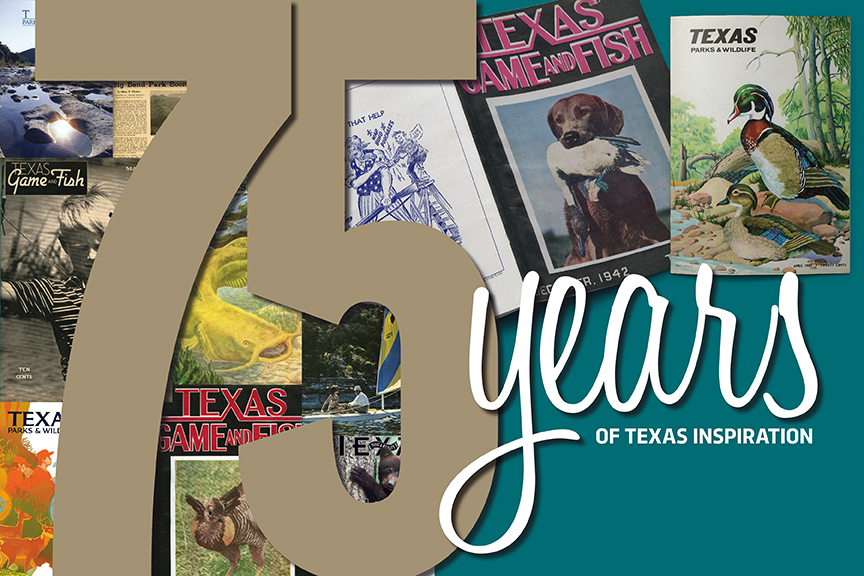
75 Years of Texas Inspiration
Since 1942, we’ve shared ‘the invigorating influence of the out-of-doors.’
By Mary-Love Bigony
Anxiety and uncertainty gripped Texans in 1942. Thousands of families waved tearful goodbyes to fathers, brothers, husbands and sons who were among the three-quarters of a million Texans who served in World War II. On the home front, rationing was a way of life, with stamp books required to purchase meat, sugar, coffee, shoes, auto parts and gasoline. Hard times.
In Austin, executives of the Game, Fish and Oyster Commission decided to publish a monthly magazine and sell it by subscription: 50 cents a year for Texas residents and $1 for out of state. The first issue of Texas Game and Fish magazine hit the mailboxes of 6,422 subscribers in December 1942. A color photo of a hunting dog graced the cover; black-and-white photos illustrated the articles inside.
Executive Secretary William J. Tucker’s editorial in the premier issue expressed optimism and set goals for upcoming issues.
“One of the aims of Texas Game and Fish during the war period shall be to inspire in all of us the traditional love of Texans for hunting, fishing and nature,” Tucker wrote. “After the harshness, brutalities and sacrifices of the present conflict the Texas man and womanhood that has succeeded in winning the war should return to a pleasanter place in which to live, with the invigorating influence of the out-of-doors doing its full share to cleanse their spirits and temper their character.”
Seventy-five years later that magazine, now Texas Parks & Wildlife, continues to offer readers ways to enjoy “the invigorating influence of the out-of-doors.” Hiking, birding, mountain biking and profiles of Texas state parks join hunting and fishing articles on these pages in modern times.

The Early Years
With World War II on the minds of all Americans, Texas Game and Fish magazine did its part by urging readers to buy war bonds. Every issue carried a full-page ad for war bonds. A May 1943 article reminded Texans that: “Fishing is more than a sport. It’s a source of wartime food. No ration points are necessary to catch a mess of fish, only an artificial lure license if you fish with artificial bait.”
An article headlined “Fliers Train in Anglers Paradise” in the April 1943 issue visited some military men in training on Matagorda Island: “Many people are disturbed about what men in service do in their off-hours. You read articles here and there about their night clubs, their honky tonking, their drinking. I recently had the privilege of spending a few days … on an island off the Gulf Coast. There were no nightspots there. They seldom have spare time under the intensive training program, but they put in every spare minute they can in hunting and fishing.”
Texas Game and Fish occasionally stepped beyond the usual fare of hunting and fishing while still focusing on “the invigorating influence of the out-of-doors.” A 1943 article titled “Big Bend Park Soon a Reality” reported that the dream many Texans had about the Big Bend country along the Rio Grande becoming a national park was approaching realization. Articles about nongame wildlife featured bats, owls, the Mississippi kite and rare birds of the Rio Grande Valley.
“Camping Notes” in June 1953 lamented declining opportunities: “The art of camping — and the attending pleasures — have all but been lost in this day of the automobile and expanding highways, which have made the wilds so easily accessible.”
The April 1957 issue’s “Wildflower Time in Texas” advised: “Texas wildflowers can supply the fisherman with the needed enticement to get his family outdoors with him in the spring. While Dad and the boys fish, Mom and the girls can enjoy nature’s exquisite blossoms.” Times have changed.
Name Change
“This month will mark the end of the Texas Game and Fish Commission, but in name only,” wrote Howard Dodgen, executive secretary, in the August 1963 issue. “The nine-member commission now serving will give way to a three-member board whose responsibilities will broaden to include administration of both state parks and wildlife affairs.”
Joan Pearsall went to work for Texas Game and Fish magazine in 1958. All Austin employees of the Texas Game and Fish Commission were housed in the Walton Building at that time.
“Mr. Dodgen called us all into his office one day — we all fit in there — and told us he had just had lunch with his friend, Governor Connally, who told him we would be merging with the State Parks Board, which was having financial difficulties,” she recalls. “And we were all going to have offices in the Reagan Building. Everyone seemed very happy about it.”
A message from Gov. John Connally appeared in the September 1963 issue: “Texas has begun a new approach to its program for the conservation and development of our wildlife and recreational resources. It is a total approach, based upon the conviction that the wise use of our lands, waters, forests, wildlife and other treasures of nature is vital to our future.”
Texas Parks & Wildlife magazine debuted in April 1965. Executive Director J. Weldon Watson explained what the new title would mean for readers. “The name coincides with the concepts of a broader readership approach toward fresh objectives in this vital field. It will certainly cater to the pyramiding numbers strictly interested in the outdoors — in our parks, in nature, in hiking, in the vaunted Texas wide open spaces.”
The magazine delivered another change to readers in October 1965: color photos on the inside pages. For the first time, readers could see the colors of the birds and animals pictured in the magazine, the colors of wildflowers carpeting the state parks.
Over the decades, as technology in photography and printing advanced, stunning outdoor images became a hallmark of Texas Parks & Wildlife magazine. This no doubt inspired many people to venture into the outdoors.
State parks were now prominent in the editorial mix. More changes were on the horizon.
A Balancing Act
Texas itself was undergoing major changes in the 20th century, as David Baxter, magazine editor from 1977 to 1998, explains.
“With the changing demographics of Texas, and a shift from a rural to an urban state, we worked to instill in our readers a love and understanding of the outdoors they probably did not have growing up in modern Texas compared to their more rural forebears of the 1940s,” Baxter says. “We did this by stretching our editorial scope to include the modern hikers, bikers and park visitors. Nor did we neglect, in my opinion as a hunter, our traditional audience of hunters and anglers.
"The TP&W magazine of the 1980s and 1990s had more of a balancing act to perform than its Game and Fish predecessor: In order to ‘cleanse their spirits and temper their character’ our editorial product had to offer something of the outdoors to every Texan. There is room in the Texas outdoors for every caring person.”
Baxter regularly received complaints from hunters about not enough hunting articles and from non-hunters about too many hunting articles. He responded to each complaint with a similar message: “Over a year’s worth of issues, we cover most all aspects of the Texas outdoors — hunting during the traditional fall and winter months; state parks, hiking and camping when seasonally appropriate."
Work by freelance writers and photographers began appearing in the magazine’s pages during the 1980s.
“Opening the pages to freelance writers and photographers broadened the scope of talent we could bring our subscribers,” Baxter says. “And realistically, it was impossible for a small staff of writers/editors and photographers to adequately cover the state.”
To pay the expenses of adding freelance talent, the magazine initiated mail offers to expand circulation, expanded single-copy newsstand sales and increased advertising outside of the small, classified-type ads that ran in the back of the book.
Gov. Ann Richards shared her thoughts on the magazine’s 50th anniversary in 1992.
“For the last half-century, this publication has served as the premier chronicle of the beauty of our state’s vast natural and recreational resources,” she wrote. “All of us who have had the pleasure of turning the pages of this magazine are reminded that Texas is indeed blessed with many natural gifts.”
A New Century
The 21st century unfolded at Texas Parks & Wildlife magazine with a special issue titled “The State of Water.” For an entire decade — 2002 to 2011 — the magazine focused the July issue each year on Texas’ various water resources and their future, which Executive Director Carter Smith calls “the defining natural resource issue in this state.” Five companion videos accompanied the series, which culminated in a “town hall” on the state of water at the Bob Bullock Texas State History Museum in Austin.
In 2015, the magazine introduced a new delivery system for readers — an app that can be downloaded to a smartphone or tablet for convenient reading anywhere and anytime.
Carter Smith was a fan of Texas Parks & Wildlife long before he took the reins as executive director of TPWD in 2008. He now writes the At Issue column each month.
“My grandmother gave me my first subscription when I was 8 or 9 years old, and I don’t think I have missed an issue since,” he says. “So, the magazine has been as much a part of my life as just about anything else in it. I wouldn’t have it any other way.”
Smith explains how the magazine has continued to honor the original goal of introducing readers to the invigorating influence of the out-of-doors to cleanse their spirits and temper their character.
“The mission of the magazine is as relevant today, if not more so, as it was when it was launched in 1942,” he says. “Perhaps more than ever, we need to redouble our efforts to share the rich diversity of the lands and waters of our home ground and to herald our proud outdoor heritage and sporting traditions. For generations, we have brought the best of Texas’ outdoors to readers indoors, so that outdoor enthusiasts young and old, rural and urban could cherish in these pages much of what we know to be so special, unique and varied about the place we call home.”
Looking toward the future, Smith sees a magazine that will continue to be relevant as it fulfills its original mission.
“As we look to the next 75 years, we will undoubtedly seek to update the look and feel of the magazine, to contemporize it and make it more accessible, both visually and digitally, in ways that we likely can’t even imagine,” he says. “And, as our state continues to grow and diversify, we will do all we can to make it as appealing and engaging to as many readers as possible.
“Ultimately, at the end of the day, the core hallmarks of this magazine will always be there for the reader to enjoy — the robust and entertaining storytelling, the profound sense of place, the jaw-dropping imagery and the focus on our wild things and wild places. Our magazine helps capture and tell the life, history and stories of our great state like no other. Rest assured, we aim to keep it that way.”
Mary-Love Bigony is a former managing editor of Texas Parks & Wildlife magazine. She retired in 2004 after 27 years with the magazine, having written 154 stories and edited countless articles. |
» Like this story? If you enjoy reading articles like this, subscribe to Texas Parks & Wildlife magazine.
